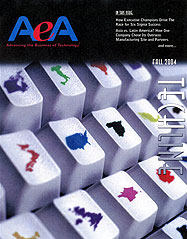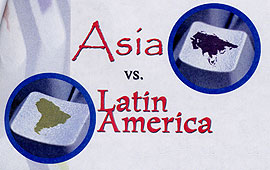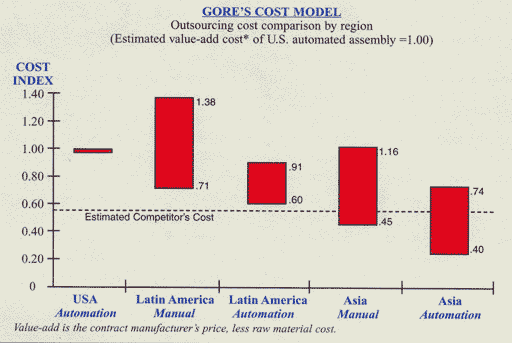|
|
||||||||||||||||||||||||||||||||||||||||||||||||||||
 |
AeA Issue Date: Fall 2004
|
|||||||||||||||||||||||||||||||||||||||||||||||||||
|
Every company, of course, has its own unique needs; and evaluating all the possible locations and potential contract manufacuring companies can be daunting. But the payoffs in cost savings and improved competitiveness can be substantial. Not long ago, for example, I helped a division of W.L. Gore & Associates, Inc. (best known for its GORE-TEX® waterproof-breathable fabric) save mil-lions of dollars annually by moving its manufacturing to Asia. The five-month process, from choosing a location to negotiating supply contracts, cost about $150,000. Gore initially was considering lower-cost contract manufacturing companies and locations in both Asia and Latin America. It also wanted help deciding whether to automate production, as it had in the U.S., or to rely on manual assembly. It needed a methodology to evaluate the relative costs and risks of each location and manufacturing approach, as well as the merits of potential partners. Some Gore officials favored Latin America for its relative ease of communications and proximity to the U.S. Not only was there less difference between languages, but Latin America offered similar time zones and would save countless hours of engineers' travel time compared with Asia. Others, though, wanted evaluation of contract manufacturing companies closer to important customers in Asia. We started by researching the safety and economic stability of Latin American countries. With much of that continent facing political unrest, crime and unstable currencies, it was relatively easy to eliminate all but Brazil, Chile, Costa Rica, Mexico and Puerto Rico. We also selected five Southeast Asian locations - China (Shenzhen), Hong Kong, Malaysia (Penang), Singapore and Thailand (Bangkok) - based on their safety, stability and proximity to Gore's support offices, plus the availability of technical infrastructure to support possible automation. Next, we used our global cost benchmarking model to estimate CM production costs in the countries of interest. While the model considers many variables, wages usually account for most of the cost difference in manufacturing. Typical wages for hand labor, for instance, range from a low of 77 cents per hour in China to $1.16 in Malaysia, $1.80 in Mexico and $13.52 in the United States (see chart #1). Wage differences are some-what less pronounced for higher-skilled positions. Process engineers, for instance, earn about $16,000 yearly in China, $21,000 in Malaysia, $32,000 in Mexico, and $54,000 in the United States. Contract manufacturing market wages are typically 20% below those paid by original equipment manufacturers. Chart #1
Wage differences usually account for most of the manufacturing product-cost differences among countries. Although overseas labor clearly is much cheaper, it's also important to consider new costs incurred for shipping longer distances, increased shipping time and inventory reserves, import duties and fees and employee travel costs. Yet even factoring in these costs, Asian contract manufacturing companies would appear to offer clear cost advantages over the convenience of Latin America. Using an indexed model of the cost of producing a composite of Gore products with automated manufacturing in the United States, we calculated that Latin American production would cost 10 percent to 40 per-cent less. But Asian production could cut the cost by as much as 60 per-cent, depending upon country location (see chart #2). Chart #2
Gore quickly realized that lower-cost Asian locations were its only realistic choice, especially since estimated competitors' production costs already were about 50 percent lower than its U.S.-based costs. But because manual assembly was almost as cost-effective as automation in much of the contract manufacturing market in Asia, the company opted not to use automation until volumes were larger and product life cycles long enough to expect minimal changes. After surveying in-country manufacturers to verify wages and other key data, we selected six potential Asian contract manufacturing companies. We then conduct-ed on-site interviews and other due diligence to select the four leading candidates, each of which was issued a request for quotation. Rather than simply selecting the lowest-cost supplier, however, we further reviewed each finalist to assess other factors, including:
The importance of this added scrutiny cannot be overstated, since it is costly to switch contract manufacturing companies, and re-qualifying a new supplier can affect sales. It's also important to assess not just potential partners, but their parents and affiliated companies, since many Asian contract manufacturing companies are subsidiaries of larger holding companies, and the health of their affiliates can have a big effect on their ability to meet their obligations. Gore narrowed its final location choices to Malaysia and Thailand, due to their low costs and the availability of technical support for custom automated assembly. Ultimately, the company selected two contract manufacturing company partners in these lower-cost countries. One ranked highly in the selection criteria. The other, although lower rated, was already being used by Gore to manufacture a few products and was qualified as a supplier by key customers. Lessons learned from this engagement, and other client work, include:
Copyright © 2004 CMC |
||||||||||||||||||||||||||||||||||||||||||||||||||||


